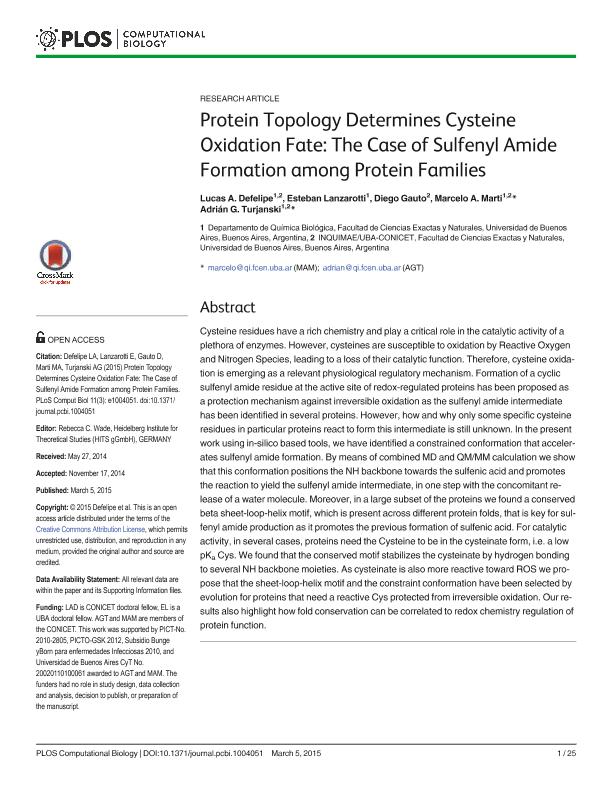Artículo
Protein Topology Determines Cysteine Oxidation Fate: The Case of Sulfenyl Amide Formation among Protein Families
Defelipe, Lucas Alfredo ; Lanzarotti, Esteban Omar
; Lanzarotti, Esteban Omar ; Gauto, Diego Fernando
; Gauto, Diego Fernando ; Marti, Marcelo Adrian
; Marti, Marcelo Adrian ; Turjanski, Adrian
; Turjanski, Adrian
 ; Lanzarotti, Esteban Omar
; Lanzarotti, Esteban Omar ; Gauto, Diego Fernando
; Gauto, Diego Fernando ; Marti, Marcelo Adrian
; Marti, Marcelo Adrian ; Turjanski, Adrian
; Turjanski, Adrian
Fecha de publicación:
03/2015
Editorial:
Public Library of Science
Revista:
Plos Computational Biology
ISSN:
1553-734X
Idioma:
Inglés
Tipo de recurso:
Artículo publicado
Clasificación temática:
Resumen
Cysteine residues have a rich chemistry and play a critical role in the catalytic activity of a plethora of enzymes. However, cysteines are susceptible to oxidation by Reactive Oxygen and Nitrogen Species, leading to a loss of their catalytic function. Therefore, cysteine oxidation is emerging as a relevant physiological regulatory mechanism. Formation of a cyclic sulfenyl amide residue at the active site of redox-regulated proteins has been proposed as a protection mechanism against irreversible oxidation as the sulfenyl amide intermediate has been identified in several proteins. However, how and why only some specific cysteine residues in particular proteins react to form this intermediate is still unknown. In the present work using in-silico based tools, we have identified a constrained conformation that accelerates sulfenyl amide formation. By means of combined MD and QM/MM calculation we show that this conformation positions the NH backbone towards the sulfenic acid and promotes the reaction to yield the sulfenyl amide intermediate, in one step with the concomitant release of a water molecule. Moreover, in a large subset of the proteins we found a conserved beta sheet-loop-helix motif, which is present across different protein folds, that is key for sulfenyl amide production as it promotes the previous formation of sulfenic acid. For catalytic activity, in several cases, proteins need the Cysteine to be in the cysteinate form, i.e. a low pKa Cys. We found that the conserved motif stabilizes the cysteinate by hydrogen bonding to several NH backbone moieties. As cysteinate is also more reactive toward ROS we propose that the sheet-loop-helix motif and the constraint conformation have been selected by evolution for proteins that need a reactive Cys protected from irreversible oxidation. Our results also highlight how fold conservation can be correlated to redox chemistry regulation of protein function.
Palabras clave:
Cysteine Oxidation
,
Sulfenylamide Formation
,
Structural Bioinformatics
,
Dftb
Archivos asociados
Licencia
Identificadores
Colecciones
Articulos(INQUIMAE)
Articulos de INST.D/QUIM FIS D/L MATERIALES MEDIOAMB Y ENERGIA
Articulos de INST.D/QUIM FIS D/L MATERIALES MEDIOAMB Y ENERGIA
Articulos(IQUIBICEN)
Articulos de INSTITUTO DE QUIMICA BIOLOGICA DE LA FACULTAD DE CS. EXACTAS Y NATURALES
Articulos de INSTITUTO DE QUIMICA BIOLOGICA DE LA FACULTAD DE CS. EXACTAS Y NATURALES
Citación
Defelipe, Lucas Alfredo; Lanzarotti, Esteban Omar; Gauto, Diego Fernando; Marti, Marcelo Adrian; Turjanski, Adrian; Protein Topology Determines Cysteine Oxidation Fate: The Case of Sulfenyl Amide Formation among Protein Families; Public Library of Science; Plos Computational Biology; 11; 3; 3-2015; 1-25
Compartir
Altmétricas



